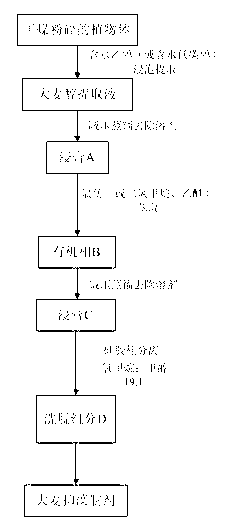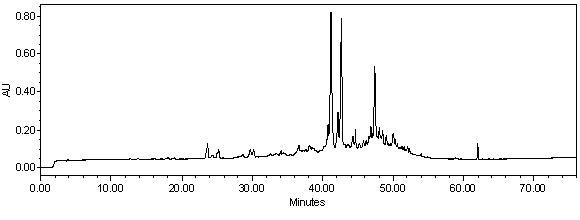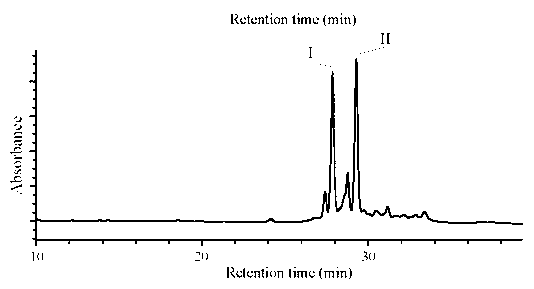Method for extracting effective algae inhibition refinement component from barley
A barley, algae inhibitory activity technology, applied in the fields of botanical equipment and methods, herbicides and algicides, chemicals for biological control, etc., can solve the problem of not being able to determine whether there are substances that promote algal growth or some unknown substances , increase the risk of use, separation of active ingredients and other problems, to achieve the effect of good algae inhibition, low price and low preparation cost
- Summary
- Abstract
- Description
- Claims
- Application Information
AI Technical Summary
Problems solved by technology
Method used
Image
Examples
Embodiment 1
[0026] Firstly, the barley straw was dried at 50° C. for 96 hours, and the dried barley was crushed to 20 meshes. Soak 400g of dry barley with 2L of aqueous ethanol with 75% alcohol content, extract 5 times at 20°C for 2 hours each time, and combine to obtain the barley alcohol extract; put the barley alcohol extract at 40°C Distill the solvent under reduced pressure in the evaporator to obtain the extract A; extract the extract A twice with chloroform whose volume is 1-1.5 times that of water, and concentrate the extract of the chloroform phase to obtain the extract B, and the HPLC spectrum of the extract B See figure 2 ;
[0027] Secondly, the extract B was subjected to silica gel column chromatography, and the eluents were dichloromethane and methanol, and the volume ratios were 100:0, 49:1, 19:1, 19:1, 4:1 and 0:100 respectively. Gradient elution was carried out, the eluent was collected respectively and the solvent was removed, and the algae inhibitory activity test wa...
Embodiment 2
[0032] Firstly, the barley straw was dried at 70° C. for 48 hours, and the dried barley was crushed to 50 mesh. Soak 1Kg of dried barley with 4.5L of ethanol containing 40% alcohol, extract 2 times at 80°C for 6 hours each time, and combine to obtain the barley alcohol extract; put the barley alcohol extract at 50°C The solvent was distilled off under reduced pressure in a rotary evaporator to obtain extract A; extract A was sequentially extracted four times with an appropriate amount of dichloromethane, and extract B was obtained after concentrating the extract from the dichloromethane phase;
[0033] Secondly, the extract B was subjected to silica gel column chromatography, and the eluent was dichloromethane:methanol, and the volume ratios were 100:0, 49:1, 19:1, 10:1, 4:1 and 0:100 respectively. Gradient elution was carried out, the eluent was collected respectively and the solvent was removed, and the algae inhibitory activity test was carried out for each eluted component...
Embodiment 3
[0039] Firstly, the barley straw was dried at 60° C. for 36 hours, and the dried barley was crushed to 30 mesh. Soak 2Kg of dried barley with 8L of 70% ethanol in water, extract 2 times at 60°C for 6 hours each time, and combine to obtain the barley alcohol extract; put the barley alcohol extract at 40°C The solvent was distilled off under reduced pressure in a rotary evaporator to obtain extract A; extract A was sequentially extracted four times with an appropriate amount of ether, and extract B was obtained after concentrating the ether phase extract;
[0040] Secondly, the extract B was subjected to silica gel column chromatography, and the eluent was dichloromethane:methanol, respectively with volume ratios of 100:0, 49:1, 19:1, 10:1, 4:1 and 0:100. Gradient elution was carried out, the eluent was collected respectively and the solvent was removed, and the algae inhibitory activity test was carried out for each eluted component, and the results are shown in Table 3:
[00...
PUM
 Login to View More
Login to View More Abstract
Description
Claims
Application Information
 Login to View More
Login to View More - R&D
- Intellectual Property
- Life Sciences
- Materials
- Tech Scout
- Unparalleled Data Quality
- Higher Quality Content
- 60% Fewer Hallucinations
Browse by: Latest US Patents, China's latest patents, Technical Efficacy Thesaurus, Application Domain, Technology Topic, Popular Technical Reports.
© 2025 PatSnap. All rights reserved.Legal|Privacy policy|Modern Slavery Act Transparency Statement|Sitemap|About US| Contact US: help@patsnap.com



